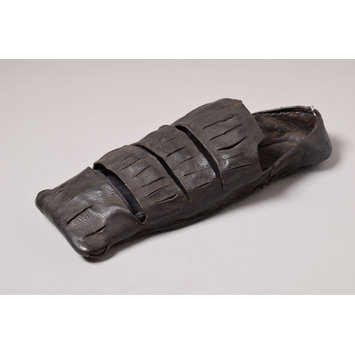My last two pairs of 1850s shoes are both in need of new soles, and as none of the vendors currently have my size in stock, it became necessary to try making another pair.
 |
| The end result has much rounder toes than expected. |
This time went better than before, notably because I now have some lasts, and was able to follow the general process in Nicole Rudolph's "
How to Make Regency &
Victorian Shoes" video instead of just relying on
Every Lady Her Own Shoemaker alone. Nicole recommends making a low shoe rather than a boot in her video, so my options were rather limited. The inspiration shoes are a pair of 1840s cotton shoes
from
the Met. I chose them because the foxing and lacing effects look similar to the popular gaiters of the 1850s, and they were one of only two
pairs of women's non-slipper shoes from the mid-19th-century I could find in my searching. While slippers appear to have been used for daily wear earlier in the century, by the 1850s they really seem relegated to formal dress for adults.
The original shoes have a figured cotton upper, which is cut in two pieces (left and right) and seamed at the center front and center back. For mine, I used a wool twill "lasting" from
Burley & Trowbridge, with scrap leather for the foxing, and white pimatex cotton for the lining.
No interior images are available, but bit of the little the center back lining seam that's visible has no raw edges; I chose to interpret this by making the lining and outside upper separately, then joining them at the binding with all the raw edges sandwiched between the layers. The shoes have six whip-stitched eyelets in their center lacings; on the originals this closes the shoe, and no tongues are visible (though they could be present and hidden under the ties, I see no evidence of this).
I originally enlarged the historic shoe image to match my shoe length, then took a series of proportions off of it (foxing should extend 1/2 way up the ~4.75" center front seam, then 1/6 of that length is a plain seam, then the final 1/3 the open placket). I'm not satisfied with how these compare in the final product to the original, but I did repeat this process for the sides of the foxing, the heel foxing, and the height of the shoe, and when taking the pattern on the last, it looked a lot closer to the original.
For the uppers, I mostly followed the process from Every Lady Her Own Shoemaker, along with what I could reason from the historic picture. After seaming the wool layer of the upper, I bound the foxing pieces with the twill tape, then laid them over the wool and topstitched into place. Close-up view of the original show 2 close rows of lockstitch or backstitch going over the tape on the foxing. After this, I lined up the lining and outer layer, a joined them by binding their upper edges. I did this by hand in order to avoid turning sharp corners on the sewing machine. I couldn't find a seam in the binding on the original, and interpreted this by putting it at the front inside corner, where the bows conceal it. It's definitely not at the center front opening, though it could have been at the center back, where the binding almost entirely worn away on both originals. The six eyelets are worked in whip stitch in a black silk buttonhole twist.
I followed Nicole's video to cut the soles and insoles, attach the upper to the last, and put everything together. She mentions in the video that using rubber cement instead of stitching the soles wouldn't become popular until 40-50 years after the Regency shoes she is making, which was nicely reassuring for me trying to make shoes from that later period.
 |
| Better than my previous pairs, but I have much to learn. |
I wore the shoes to cook at Fort Nisqually last Sunday. It poured rain all day, but I contrived to stay indoors most of the time. I did end up crossing the yard ~3 times, and found these adequate. They only felt a little damp on the second two excursions, and dried out very quickly (in fairness, I was keeping to the paths and trying to avoid puddles and wet grass). The shoes were a little looser than I feared/expected, though nowhere near as floppy as the plaid gaiters I made before. There is room for my insoles, which made them much more comfortable than most of my other period shoes, though they feel lighter and flimsier than my purchased shoes.
Appearance-wise, I have a laundry list of problems, from the very rounded appearance of the toe (the last actually has a square toe, albeit with more of a curve along the outside edge than I'd like) to the crooked foxing, to the two places where I shaved of the turned leather too close to the edge of the sole. Despite edging and burnishing, the soles are a bit rougher around the edges than I'd like. The sole-upper-insole layers were rough and clumsy-looking despite my attempts to even things out, but somehow this didn't end up making the shoes uncomfortable.
In the end, I'd call this "serviceable" and "the most accurate shoe option currently available to me," but I'm also going to try getting my Balmoral boots and/or walking shoes re-soled for outdoor use. These lighter shoes I'll keep for indoor and summer events (where the light uppers should be very comfortable).

























